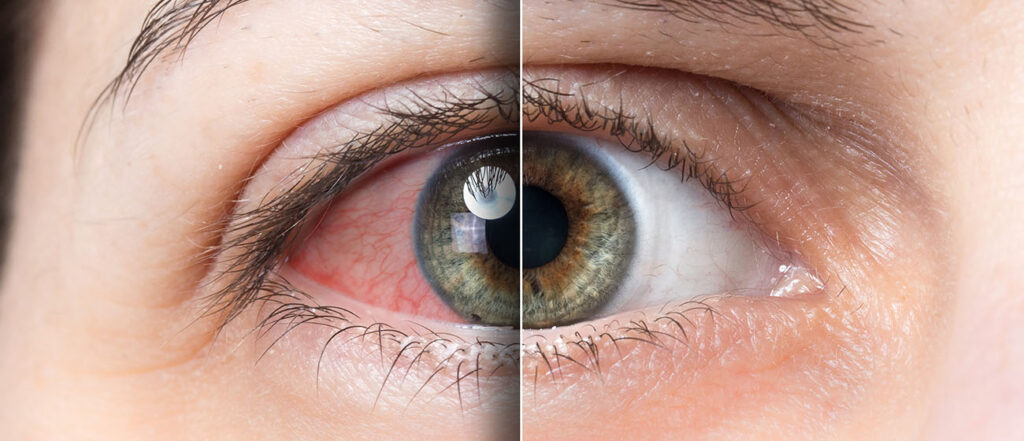
Doctors frequently encounter individuals who report experiencing dry eye symptoms.The prevalence of dry eye issues has risen due to extended periods of screen exposure, including monitors and mobile devices. Patients commonly describe sensations of eye itchiness, dryness, redness, and eyestrain. The best way to get rid of the symptoms of this condition is to go for Ayurvedic dry eye treatment from a renowned hospital.
Dry eyes: What it is
As per Ayurvedic doctors, metabolic issues, allergies, or autoimmune disorders can also contribute to dry eye conditions. If left unaddressed, prolonged dry eye can result in corneal ulcers, conjunctivitis, difficulties with activities like keeping the eyes open, reading, and writing. In some cases without proper Ayurvedic treatment for dry eyes, individuals might even experience increased anxiety, stress, and depression.
The outer layer of the eye is covered by a shielding layer of tears. Glands situated around the eye generate fresh tears, maintaining a balanced moisture level within the eye. This shielding layer holds significance in ensuring comfort and maintaining clear vision. Certain individuals experience insufficient tear production, leading to discomfort. This prevalent eye condition is referred to as dry eye.
The Ayurvedic Perspective on Dry Eye
Ayurveda views the body as composed of the panchmahabhoot (five elements) and guided by the tridosha principles. The eyes primarily embody the pitta dosha and agni mahabhoot, while other mahabhoot and doshas have a lesser influence. Any occurrence of dryness (rukshta) in the body is attributed to the disturbance of vata dosha. The ushna guna of pitta contributes to dryness in the eyes, thus involving both vata and pitta in dry eye conditions. Aggravation of the rough and dry qualities (Ruksha and khar guna) of vata, combined with the warmth (usna guna) of pitta dosha, leads to sensations of roughness, foreign body presence, and burning in the eyes.
Doshas: Vata and Pitta
Channels: Rasvah, Asruvah, and Raktvah Srotas
Affected Tissues: Ras Dhatu, and Rakta Dhatu
Types of Imbalance: Kshaya and Srotavrodha
Types of dry eyes:
- Inadequate tear production
- Inefficient tear retention
- Excessive tear evaporation
Symptoms of dry eyes:
Dry eye syndrome can lead to a variety of symptoms and these can be managed with natural treatment for dry eyes. Some symptom are:
- Redness or soreness in the eyes
- Excessive tearing
- A sensation of stinging or burning in the eyes
- Feeling as if there’s grit in the eyes
- Presence of stringy mucus in or around the eyes
- Increased sensitivity of the eyes to smoke or wind
- Sensitivity to light
- Blurred vision, particularly as the day progresses
- Occasional double vision
- Eye fatigue, especially after reading, even for short durations
- Challenges in maintaining eye openness
- Discomfort while wearing contact lenses
- Eyelids sticking together upon waking up
Treatment in Ayurveda: Netra Tarpana
- Netra Tarpana
The term “Netra Tarpana” originates from two Sanskrit words: “netra,” signifying eyes, and “tarpana,” denoting rehydration. This technique employs ghee, which is clarified butter. Ghee possesses healing properties beneficial for fatigued, stressed, dehydrated eyes, as well as for addressing irregular eyesight. Netra Tarpana involves a process in which circular frames, crafted from a powdered Masha paste, encircle the eyes. Subsequently, lukewarm medicated ghee (chosen in accordance with the dosha) is gently poured into these frames. The patient is advised to alternate between opening and closing their eyes during the procedure, allowing the medicinal properties of the liquefied Ghrita to permeate. The duration for which the Ghrita should remain on the eyes depends on the severity of the condition.
Netra Tarpana serves to cool, lubricate, and rejuvenate the eyes. This therapeutic approach enhances internal vision by cleansing even the tiniest channels associated with both inner and outer perception. It contributes to restoring clarity to the eyes by expelling impurities and rectifying ailments. Additionally, Netra Tarpana plays a role in addressing initial stages of conditions of many other diseases other than just dry eyes. It is one of the methods for cataract treatment without surgery, insomnia, glaucoma, and conjunctivitis.
The Netra Tarpana treatment revitalizes the eyes, alleviating accumulated stress and promoting the seamless functioning of these vital marmas.
The duration of the procedure, spanning up to a maximum of five days, is contingent upon the patient’s dosha constitution and the seriousness of the issue. Even the medicinal formulation and the type of Ghrita utilized vary in accordance with the Vata, Pitta, and Kapha doshas. The treatment duration ranges from one to five days, ensuring comprehensive healing and complete nourishment for the eyes.
Tarpana possesses preventive attributes as well, extending beyond its curative aspects. Even individuals in excellent health could consider incorporating this therapy into their daily routine to safeguard their eyes from potential harm.